note General note
Communities of resistance and political ontologies of water as a common in stagiates, Greece
This note is part of the Commoning Beyond Growth Workshop, which took place in Nottingham from June 5 to 7, 2024.
Cette note s'inscrit dans le colloque le Commoning au-delà de la croissance, qui a eu lieu à Nottingham du 5 au 7 juin 2024.
💡 Une traduction de la note en français est disponible plus bas.
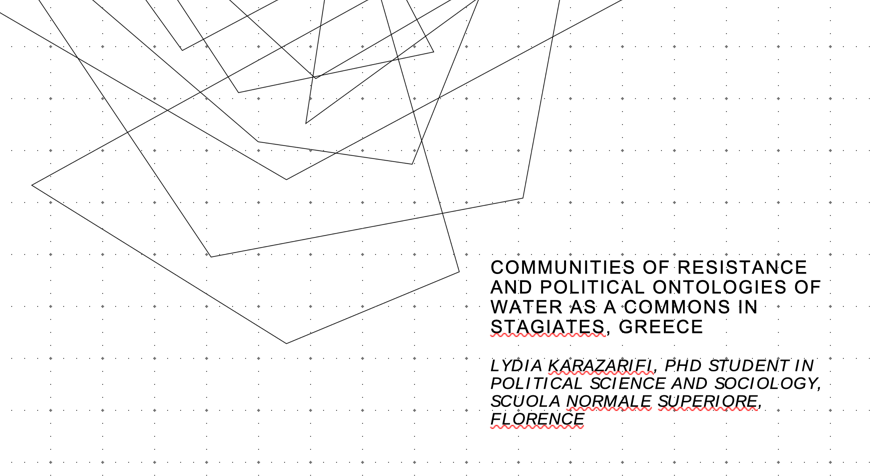
What makes water a common in times of crises?
How do collective and social direct actions shape political ontologies of water as a commons in times of crises?
How are the processes of commoning related to water performed in multilayered crises beyond the market and the state mechanisms widening the space for alternatives?
Stagiates Context
- Methods: Ethnography & Secondary document analysis
- Data derived from a two-month ethnographic fieldwork

Introduction
Crisis can acquire different meanings depending on the contextualized socio-historical interpretations (Koselleck and Richter 2006).
Connected to time & space: a temporary lens of an emergency, calling up for solutions from a top-down or a bottom-up approach or a continuous framework of negotiations and struggles related to power structures and mechanisms. It is also linked to some expectations whether are apocalyptic or moving constructions towards alternatives.
Crisis as a critical juncture unfolding challenges and political opportunities for social change (Della Porta et al. 2017).
Water in times of crises -Three Directions:
- Economic-Political Processes / neoliberalization of water (Della Porta 2015; Bieler 2021; Bieler and Jordan 2018; Gasseau 2024).
- Social Mobilizations related to water as a commons (Muehlebach 2023; Moore 2018; Bieler 2021; Νικολάου 2017).
- Environmental degradation/climate change linked to modes of development and social processes (Vera-Cortés and Macías-Medrano 2020; Kaika 2006). Neoliberalization of Nature (Pellizzoni 2011).
Theorical framework
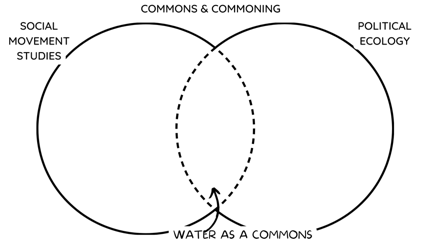
Why political ontologies ?
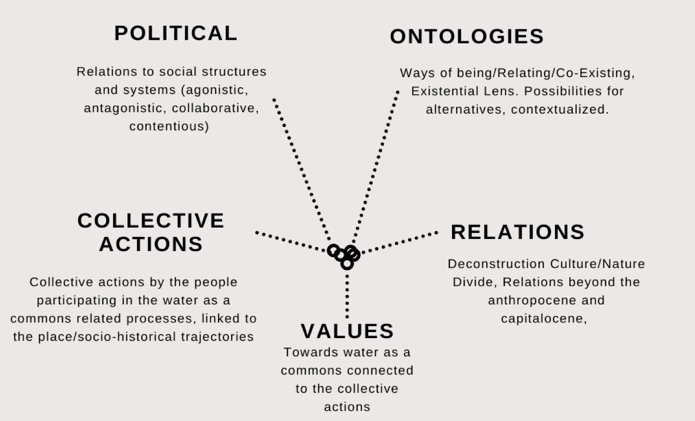
- Political
- Relations to social structures and systems (agonistic, antagonistic, collaborative, contentious)
- Ontologies
- Ways of being/Relating/Co-existing, Existantial lens,
- Possibilities for alternatives, contextualized
- Relations
- Deconstruction culture/nature, Divide, Relations beyond the anthropocene and capitalocene
- Values
- Towards water as a commons connected to the collective actions
- Collective actions
- Collective actions by the people participating in the water as a commons related processes, linked ot the place/socio-historical trajectories.
Political Ontologies (as continuous and collective processes of being and shaping that are open-ended, contested and driven by collective practices.
The context of Stagiates
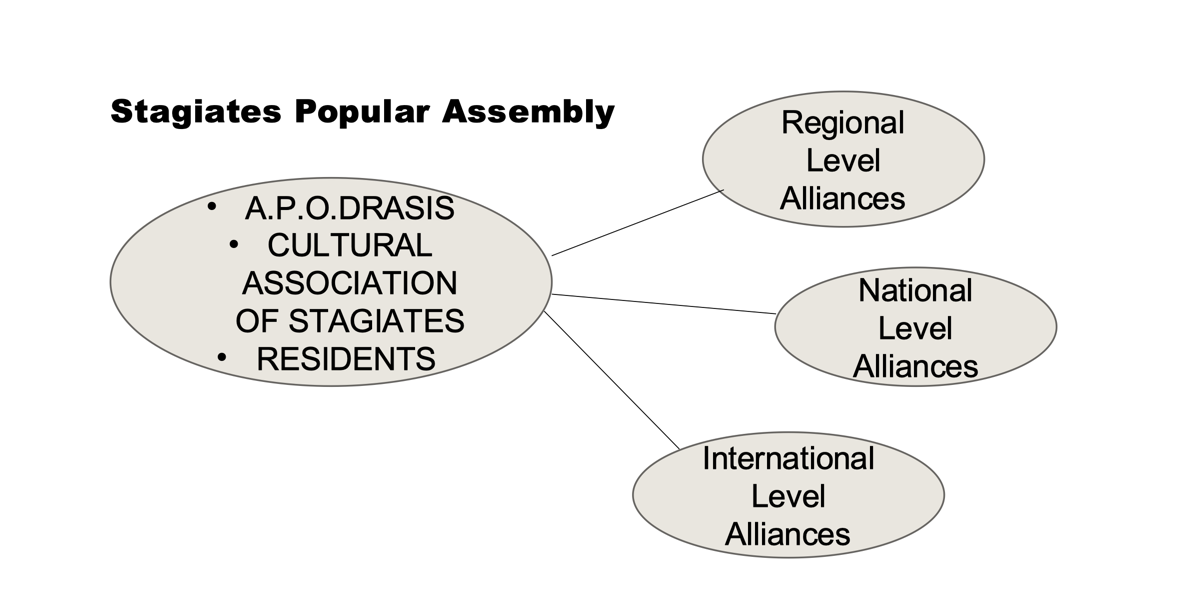
Stagiates popular assembly
- A.P.O. Drasis
- Cultural association of stagiates
- Residents
Levels
- Regional level alliances
- National level alliances
- International level alliances
Timeline Diagram: Stagiates context
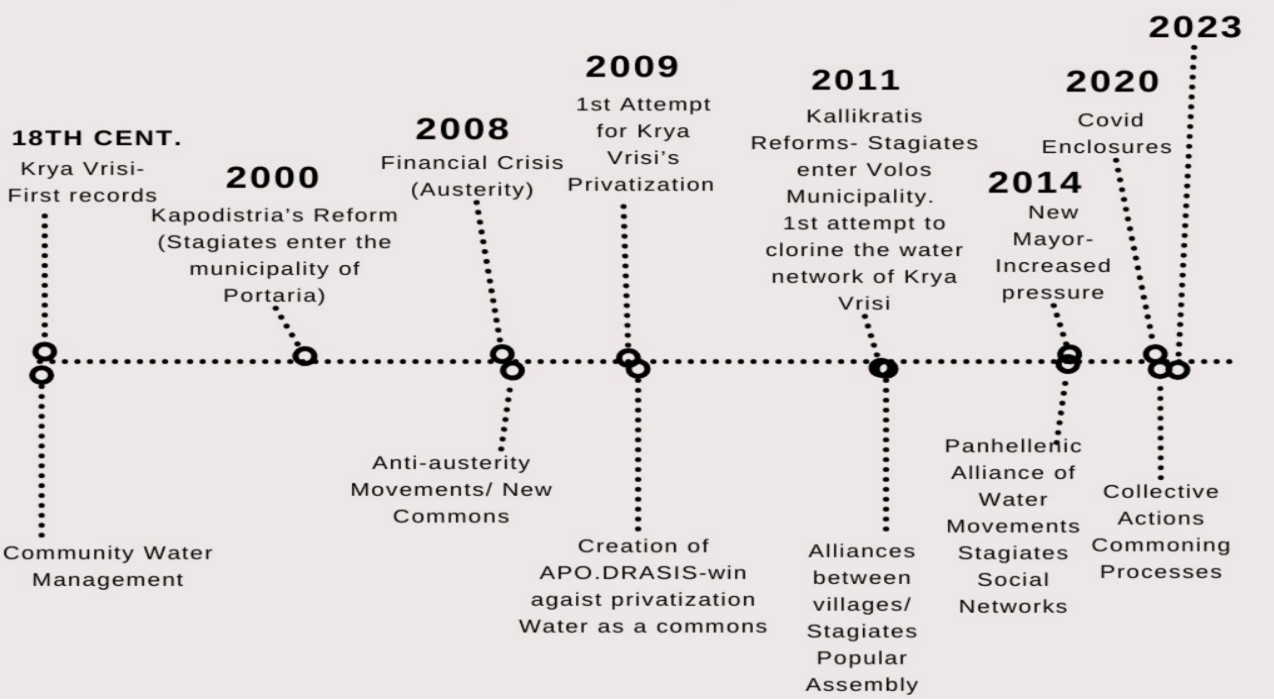
- 18th cent.
- Krya Vrisi first records
- Community Water Management
- 2000
- Kapodistria's Reform : stagiates enter the municipality of Portaria
- 2008
- Financial crisis (auterity)
- Anti-austerity movements, new commons
- 2009
- 1st attempts for Krya Vrisi's privatization
- Creation of APO.DRASIS - win against privatization, Water as a commons
- 2011
- Kallikratis Reforms - Stagiates enter Volos Municipality. 1st attemps to clorine the water network of Krya Vrisi
- Alliances between villages, Stagiates popular assembly
- 2014
- New Mayor - Increased pressure
- Panhellenic alliance of water movements Stagiates social networks
- 2020
- Covid enclosure
- Collectives actions, commoning processes
- 2023



Preliminary findings : "free water" & Krya Vrisi
The historical routes of the place interplay with the relations with the water as a commons. Krya Vrysi water source: historical point of reference, point of socialisation processes, socio-psychological connections in the life activities.
Organizational dynamics and direct action provided water as a commons with significations of a dynamic creation of a community network in and out of the village. Stagiates popular assembly follows a “bottom-up collaborative and inclusive decision making (open democracy)” (Apostolopoulou et al. 2022:154).
The repertoires of direct action interplayed with contention concerning the municipality and the local authorities and were essential for the creation of different political ways of existing and co-existing derived from the collective actions towards the protection of water as a commons.
Solidarity and provision for the community have been central values coming out of the collective actions connected to water as a commons.
Intersected social struggles .“The social struggles and especially the environmental ones are rather interconnected, and they can be seen as such”.
The emotional connection with water as a commons emerged through the collective actions towards the maintenance of water and the connected spaces, as well as the organization of different cultural activities and actions to protect water as a commons.
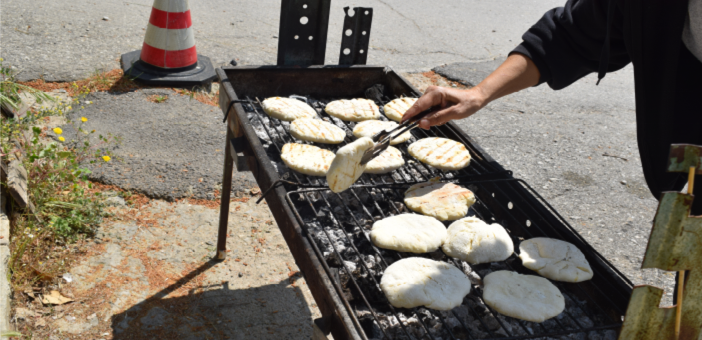
Preliminary findings : water as a common in extreme weather phenomena
What happened during the Daniel and Elias phenomena?
A natural disaster was combined with a gap in the preparedness for this emergency by the state’s mechanisms. It appeared that bottom-up and direct social actions were quicker and often more adequate towards solidarity and care for the population in many instances (i.e. collective cleaning and cooking).
Huge amount of bottled water that was bought or given in contrast with the water transferred by the water sources of Krya Vrisi.
The interconnected character of the intersected socioenvironmental struggles emerged very clearly through the common spaces of help provision, the solidarity networks and the “water-on-the-move” where was needed.
The people in Stagiates started cultivating the governance of emergencies by constructing a mobile fire-protection system, a mobile water-provision system and next activities for the reparation of the paths and destroyed places that are linked to the irrigation system. The reparation took a substantial character in the organization of the collective actions.
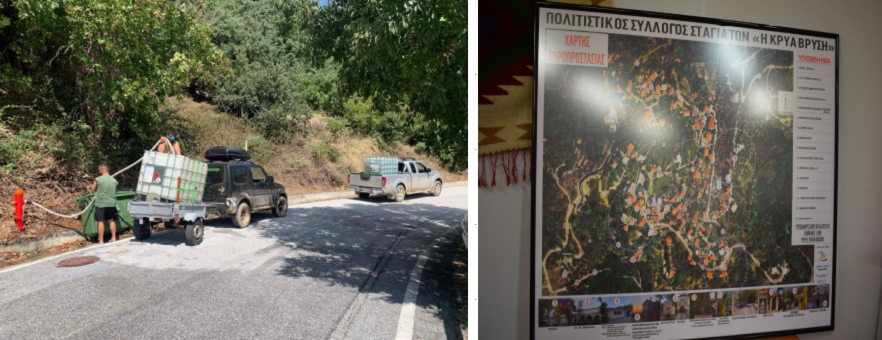
Some conclusions & points for reflection
The history of the place interplays to the commoning connected to practices and values. These practices unfold ongoing patterns of connectedness and adaptability concerning the needs of the place and the people, as well as the commons reproduction towards care.
The unfolding political ontologies can correspond to the bottom-up relations towards the covering of the needs, the improvement of the collective living realities and the relation with water under a sociopsychological, eco-political prism.
The solidarity and quick reflexes connected to direct actions in times of crisis outline the adaptability based on reparation and care and resistance to the monolithic concept of crisis and climate change emergencies.
Water acquired the connective character in a chain of plural and intersected relations within social and environmental struggles. Apart from that, it became a connective circle of a community within other communities enacting for the commons and care.
The political ontologies in the commoning processes can provide us with essential elements regarding possible collaborations towards alternatives beyond the Anthropocene and Capitalocene (Tsing 2015; Kanngieser and Beuret 2017). Need for further research.
The spheres between social and natural realms of action were interconnected towards the protection of goods, and reshaping of relations and practices towards care. Questions regarding the commoning of water; what is nature and culture? Where can the different needs and realities be met in the Pluriverse? (Escobar 2020).

Traduction en français
Présentation par Lydia Karazarifi via IA par Marie-Soleil L'Allier
Qu'est-ce qui rend l'eau un bien commun en temps de crise ?
Comment les actions collectives et sociales directes façonnent-elles les ontologies politiques de l'eau en tant que commun en temps de crise ?
Comment les processus de commoning liés à l'eau se manifestent-ils dans des crises multiformes, au-delà des mécanismes du marché et de l'État, en élargissant l'espace pour des alternatives ?
Contexte de Stagiates
- Méthodes : Ethnographie et analyse de documents secondaires
- Données dérivées d'un travail de terrain ethnographique de deux mois

Introduction
La crise peut acquérir différentes significations selon les interprétations socio-historiques contextualisées (Koselleck et Richter 2006).
Connectée au temps et à l'espace : une vision temporaire d'une urgence, appelant à des solutions par une approche descendante ou ascendante, ou un cadre continu de négociations et de luttes liées aux structures et mécanismes de pouvoir. Elle est également liée à certaines attentes, qu'elles soient apocalyptiques ou orientées vers des alternatives.
La crise comme une conjoncture critique dévoilant des défis et des opportunités politiques pour le changement social (Della Porta et al. 2017).
L'eau en temps de crise - Trois directions :
- Processus politico-économiques / néolibéralisation de l'eau (Della Porta 2015; Bieler 2021; Bieler et Jordan 2018; Gasseau 2024). M
- obilisations sociales liées à l'eau en tant que commun (Muehlebach 2023; Moore 2018; Bieler 2021; Νικολάου 2017).
- Dégradation environnementale/changement climatique liés aux modes de développement et aux processus sociaux (Vera-Cortés et Macías-Medrano 2020; Kaika 2006). Néolibéralisation de la nature (Pellizzoni 2011).
Cadre théorique
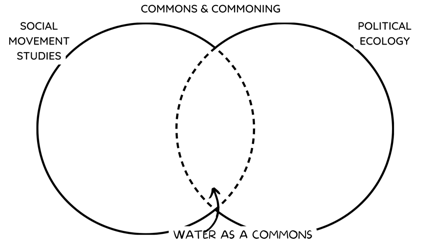
Communs et commoning
- À l'intersection des études sur les mouvements sociaux et de l'écologie politique, se trouve l'eau comme un commun
Pourquoi les ontologies politiques ?
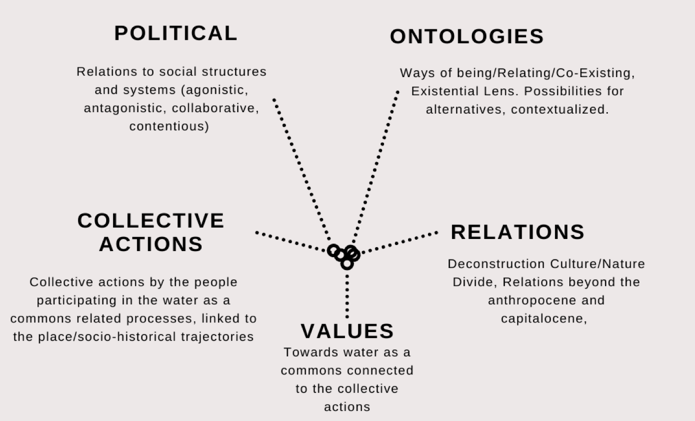
- Politique
- Relations avec les structures et systèmes sociaux (agonistiques, antagonistiques, collaboratifs, contentieux)
- Ontologies
- Manières d'être / de se rapporter / de coexister, vision existentielle, possibilités d'alternatives, contextualisées
- Relations
- Déconstruction de la culture/nature, division, relations au-delà de l'anthropocène et du capitalocène
- Valeurs
- Vers l'eau en tant que commun liée aux actions collectives
- Actions collectives
- Actions collectives par les personnes participant aux processus liés à l'eau en tant que commun, liées au lieu / trajectoires socio-historiques.
Ontologies politiques (comme des processus continus et collectifs d'être et de se modeler, ouverts, contestés et motivés par des pratiques collectives).
Le contexte des Stagiates
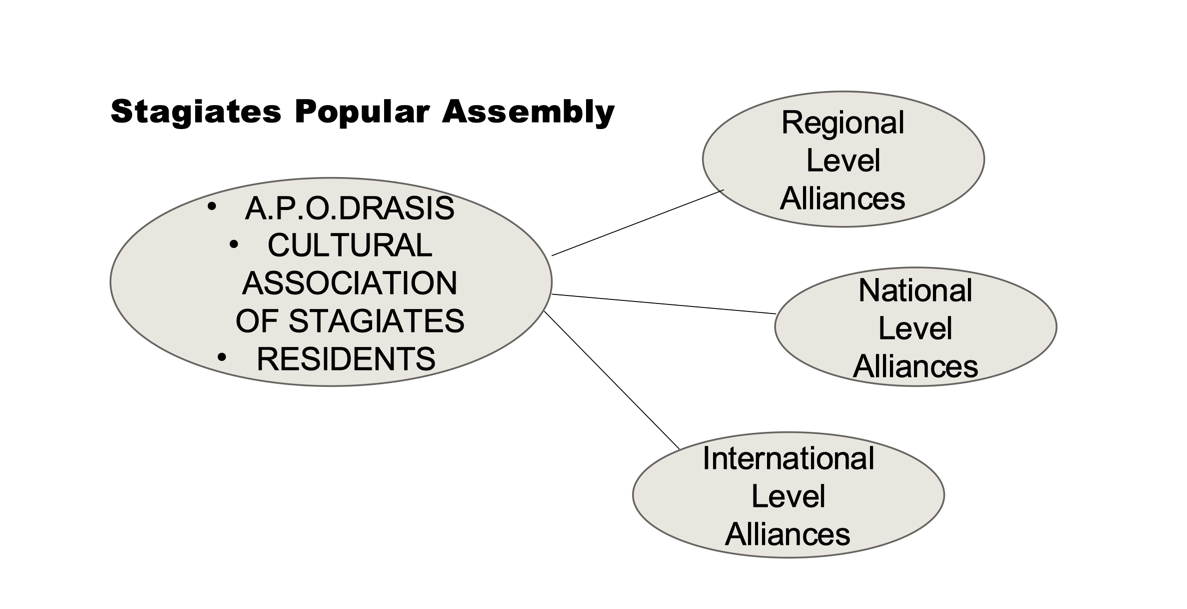
Assemblée populaire de Stagiates
- A.P.O. Drasis
- Association culturelle de Stagiates
- Résidents
Niveaux
- Alliances au niveau régional
- Alliances au niveau national
- Alliances au niveau international
Diagramme chronologique : Contexte de Stagiates
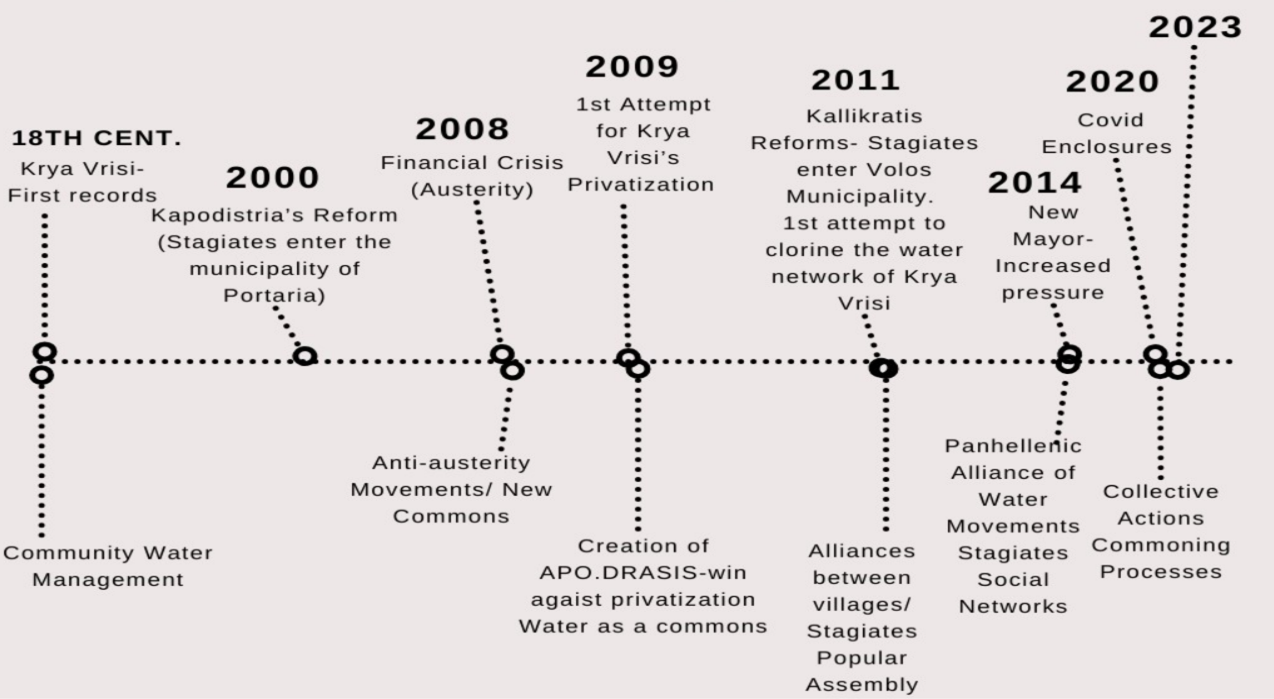
- 18e siècle
- Premières mentions de Krya Vrisi
- Gestion communautaire de l'eau
- 2000
- Réforme de Kapodistrias : Stagiates entre dans la municipalité de Portaria
- 2008
- Crise financière (austérité) ;
- Mouvements anti-austérité, nouveaux communs
- 2009
- Premières tentatives de privatisation de Krya Vrisi ;
- Création de l'APO.DRASIS - victoire contre la privatisation, l'eau en tant que commun
- 2011
- Réformes de Kallikratis - Stagiates entre dans la municipalité de Volos; Premières tentatives de chloration du réseau d'eau de Krya Vrisi ;
- Alliances entre villages, assemblée populaire de Stagiates
- 2014
- Nouveau maire - Pression accrue ;
- Alliance panhellénique des mouvements pour l'eau, réseaux sociaux de Stagiates
- 2020
- Confinement dû au Covid ;
- Actions collectives, processus de commoning
- 2023



Résultats préliminaires : "eau libre" et Krya Vrisi
Les trajectoires historiques du lieu s'entrelacent avec les relations avec l'eau en tant que commun. La source d'eau de Krya Vrisi : point de référence historique, point des processus de socialisation, connexions socio-psychologiques dans les activités de la vie.
Les dynamiques organisationnelles et les actions directes ont fourni à l'eau en tant que commun des significations d'une création dynamique d'un réseau communautaire à l'intérieur et à l'extérieur du village. L'assemblée populaire de Stagiates suit une "prise de décision collaborative et inclusive de bas en haut (démocratie ouverte)" (Apostolopoulou et al. 2022:154).
Les répertoires d'actions directes se sont entremêlés avec la contestation concernant la municipalité et les autorités locales et étaient essentiels pour la création de différentes manières politiques d'exister et de coexister, issues des actions collectives en faveur de la protection de l'eau en tant que commun.
La solidarité et la provision pour la communauté ont été des valeurs centrales émanant des actions collectives liées à l'eau en tant que commun.
Lutte sociales entrecroisées. "Les luttes sociales et en particulier celles environnementales sont plutôt interconnectées et peuvent être vues comme telles".
La connexion émotionnelle avec l'eau en tant que commun a émergé à travers les actions collectives pour la maintenance de l'eau et des espaces connexes, ainsi que l'organisation de différentes activités et actions culturelles pour protéger l'eau en tant que commun.
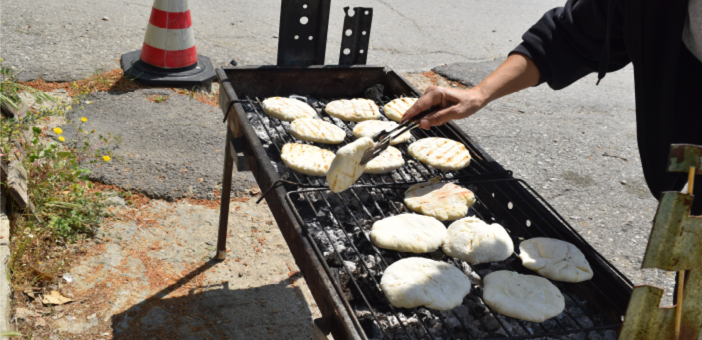
Résultats préliminaires : l'eau en tant que bien commun face aux phénomènes météorologiques extrêmes
Que s'est-il passé lors des phénomènes Daniel et Elias ?
Une catastrophe naturelle a été combinée à un manque de préparation à cette urgence par les mécanismes de l'État. Il est apparu que les actions sociales directes et ascendantes étaient plus rapides et souvent plus adéquates en termes de solidarité et de soins pour la population dans de nombreuses situations (c'est-à-dire nettoyage et cuisine collectifs).
Une grande quantité d'eau en bouteille a été achetée ou donnée en contraste avec l'eau transférée par les sources d'eau de Krya Vrisi.
Le caractère interconnecté des luttes socio-environnementales entrecroisées est apparu très clairement à travers les espaces communs d'aide, les réseaux de solidarité et le "water-on-the-move" là où c'était nécessaire.
Les habitants de Stagiates ont commencé à cultiver la gouvernance des urgences en construisant un système mobile de protection contre les incendies, un système mobile de distribution d'eau et des activités futures pour la réparation des chemins et des lieux détruits liés au système d'irrigation. La réparation a pris un caractère substantiel dans l'organisation des actions collectives.
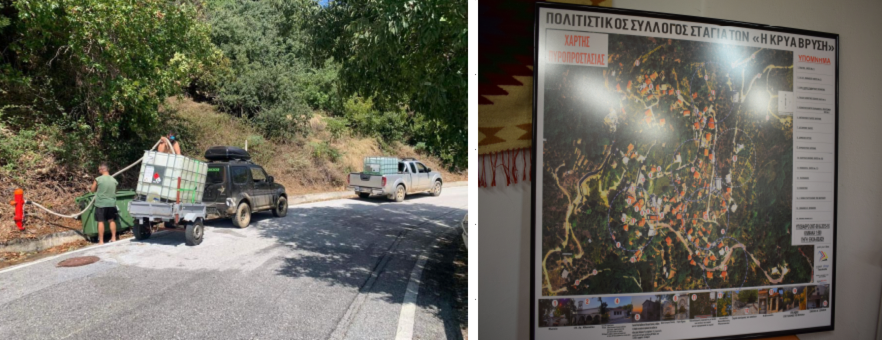
Quelques conclusions et points de réflexion
L'histoire du lieu s'entrelace avec le commoning lié aux pratiques et aux valeurs. Ces pratiques révèlent des schémas continus de connectivité et d'adaptabilité concernant les besoins du lieu et des habitants, ainsi que la reproduction des communs en faveur des soins.
Les ontologies politiques émergentes peuvent correspondre aux relations ascendantes pour couvrir les besoins, améliorer les réalités de vie collective et la relation avec l'eau sous un prisme socio-psychologique et éco-politique.
La solidarité et les réflexes rapides liés aux actions directes en temps de crise soulignent l'adaptabilité basée sur la réparation et les soins, et la résistance au concept monolithique de crise et d'urgences climatiques.
L'eau a acquis un caractère de connexion dans une chaîne de relations plurielles et entrecroisées au sein des luttes sociales et environnementales. De plus, elle est devenue un cercle de connexion d'une communauté au sein d'autres communautés agissant pour les communs et les soins.
Les ontologies politiques dans les processus de commoning peuvent nous fournir des éléments essentiels concernant les collaborations possibles vers des alternatives au-delà de l'Anthropocène et du Capitalocène (Tsing 2015 ; Kanngieser et Beuret 2017). Besoin de recherches supplémentaires.
Les sphères entre les domaines d'action sociale et naturelle étaient interconnectées pour la protection des biens, le remodelage des relations et des pratiques vers les soins.
Des questions concernant le commoning de l'eau ; qu'est-ce que la nature et la culture ? Où peuvent se rencontrer les différents besoins et réalités dans le Plurivers ? (Escobar 2020).
note Linked note(s)
 12 June 2024
12 June 2024
Lydia Karazarifi
12 June 2024 21 February 2024
21 February 2024
Marie-Soleil L’Allier s'intéresse aux communs
21 February 2024Linked notebook(s)
 file_copy
155 notes
file_copy
155 notes
Tous les savoirs répertoriés par Cultiver les communs
file_copy 155 notes file_copy
61 notes
file_copy
61 notes
Commoning Beyond Growth
file_copy 61 notesAuthor(s) of note
Contact the authorLinked community
Commoning Beyond Growth
Location
More informationPublished
July 12, 2024
Edited
July 12, 2024, 4:29 p.m.
Licence
CC BY-NC-SA, without authorized commercial use - plus d'informations
Alert: a part or the whole of this content might not be the property of the author or authors of the note. If needed, find out about conditions for re-use.
Visibility
public
Quote this note
Marie-Soleil L'Allier. (2024). Communities of resistance and political ontologies of water as a common in stagiates, Greece. Praxis (consulted July 15, 2024), https://praxis.encommun.io/en/n/lgx9MfXP3EwLrRJuqYYSqtoAU2I/.
shareCopy